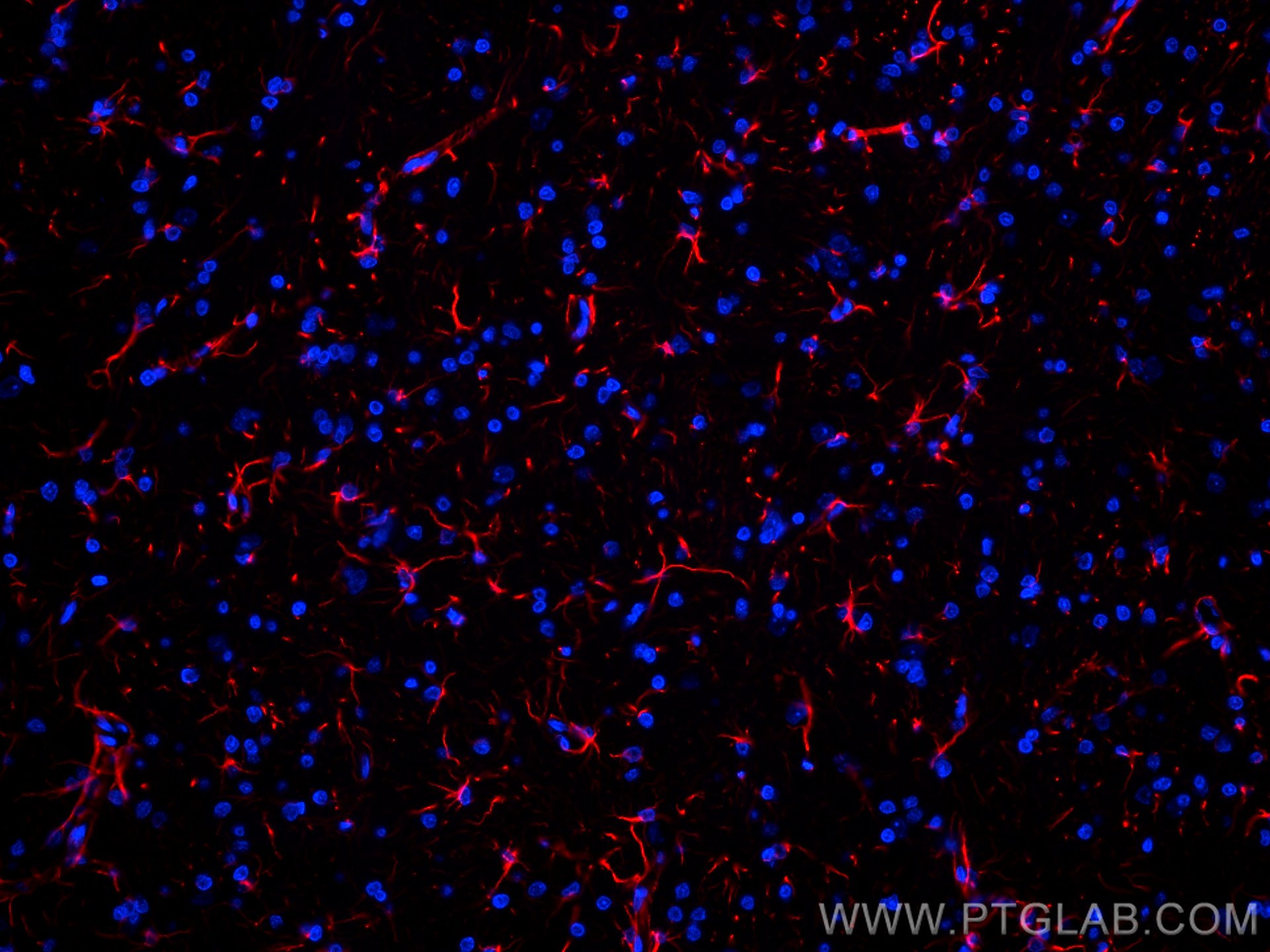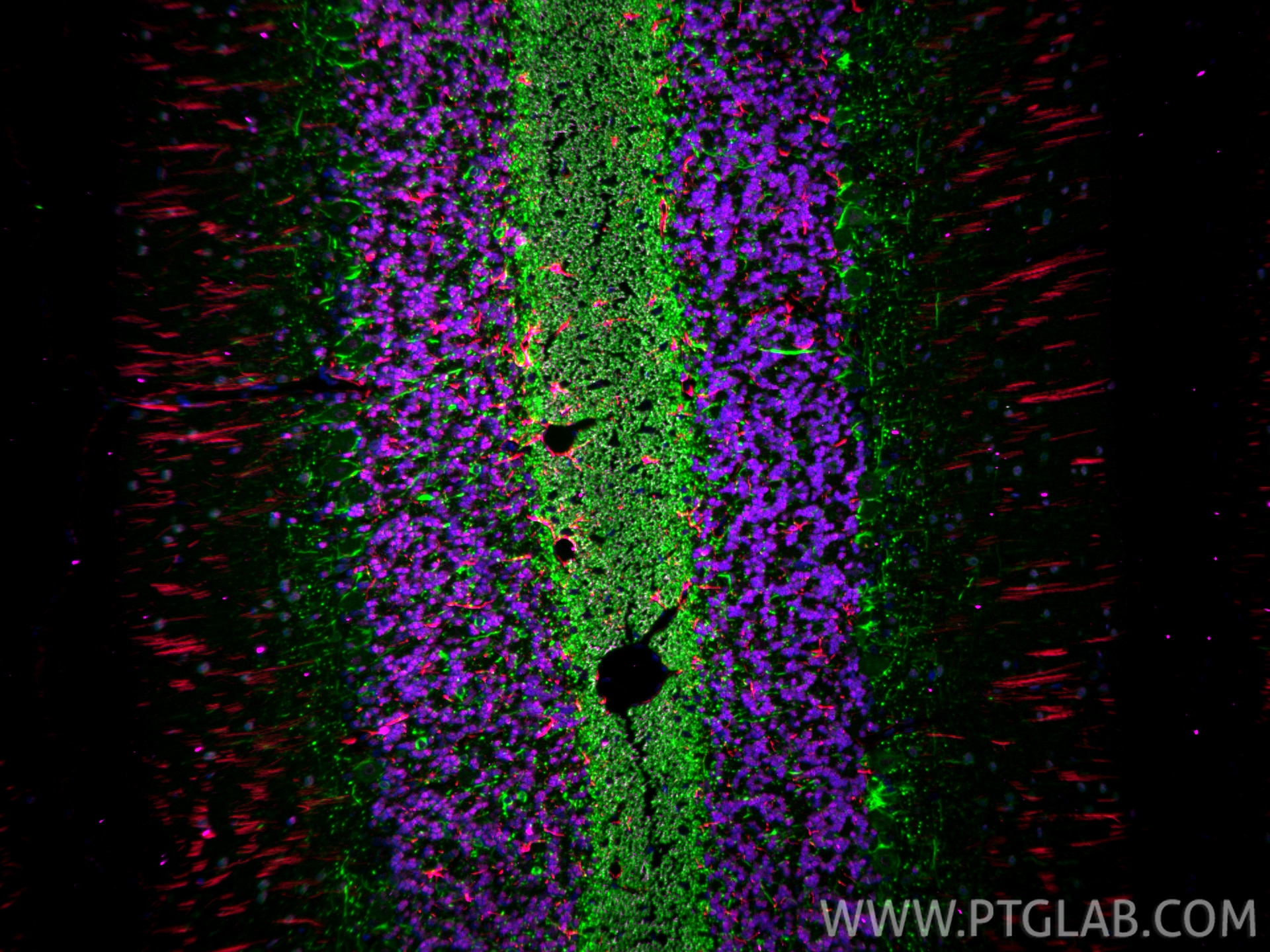GFAP Monoklonaler Antikörper
GFAP Monoklonal Antikörper für IF-P
Wirt / Isotyp
Maus / IgG2a
Getestete Reaktivität
Hausschwein, human, Maus, Ratte
Anwendung
IF-P
Konjugation
CoraLite®594 Fluorescent Dye
CloneNo.
4B2E10
Kat-Nr. : CL594-60190
Synonyme
Geprüfte Anwendungen
| Erfolgreiche Detektion in IF-P | Rattenhirngewebe, Ratten-Cerebellum-Gewebe |
Empfohlene Verdünnung
| Anwendung | Verdünnung |
|---|---|
| Immunfluoreszenz (IF)-P | IF-P : 1:50-1:500 |
| It is recommended that this reagent should be titrated in each testing system to obtain optimal results. | |
| Sample-dependent, check data in validation data gallery | |
This antibody is not recommended for immunocytofluorescent assays. It is not suitable for frozen sections.
Veröffentlichte Anwendungen
| IF | See 4 publications below |
Produktinformation
CL594-60190 bindet in IF-P GFAP und zeigt Reaktivität mit Hausschwein, human, Maus, Ratten
| Getestete Reaktivität | Hausschwein, human, Maus, Ratte |
| In Publikationen genannte Reaktivität | Maus |
| Wirt / Isotyp | Maus / IgG2a |
| Klonalität | Monoklonal |
| Typ | Antikörper |
| Immunogen | GFAP fusion protein Ag10452 |
| Vollständiger Name | glial fibrillary acidic protein |
| Berechnetes Molekulargewicht | 432 aa, 50 kDa |
| GenBank-Zugangsnummer | BC013596 |
| Gene symbol | GFAP |
| Gene ID (NCBI) | 2670 |
| Konjugation | CoraLite®594 Fluorescent Dye |
| Excitation/Emission maxima wavelengths | 588 nm / 604 nm |
| Form | Liquid |
| Reinigungsmethode | Protein-A-Reinigung |
| Lagerungspuffer | PBS with 50% glycerol, 0.05% Proclin300, 0.5% BSA |
| Lagerungsbedingungen | Bei -20°C lagern. Vor Licht schützen. Nach dem Versand ein Jahr stabil. Aliquotieren ist bei -20oC Lagerung nicht notwendig. 20ul Größen enthalten 0,1% BSA. |
Hintergrundinformationen
GFAP Function GFAP (Glial fibrillary acidic protein) is a type III intermediate filament (IF) protein specific to the central nervous system (CNS). GFAP is one of the main components of the intermediate filament network in astrocytes and has been proposed as playing a role in cell migration, cell motility, maintaining mechanical strength, and in mitosis. Tissue specificity GFAP is expressed in central nervous system cells, predominantly in astrocytes. GFAP is commonly used as an astrocyte marker. However, GFAP is also present in peripheral glia and in non-CNS cells, including fibroblasts, chondrocytes, lymphocytes, and liver stellate cells (PMID: 21219963). Involvement in disease Mutations in GFAP lead to Alexander disease (OMIM: 203450), an autosomal dominant CNS disorder. The mutations present in affected individuals are thought to be gain-of-function. Upregulation of GFAP is a hallmark of reactive astrocytes, in which GFAP is present in hypertrophic cellular processes. Reactive astrogliosis is present in many neurological disorders, such as stroke, various neurodegenerative diseases (including Alzheimer's and Parkinson's disease), and neurotrauma. Isoforms Astrocytes express 10 different isoforms of GFAP that differ in the rod and tail domains (PMID: 25726916), which means that they differ in molecular size. Isoform expression varies during the development and across different subtypes of astrocytes. Not all isoforms are upregulated in reactive astrocytes. Post-translational modifications Intermediate filament proteins are regulated by phosphorylation. Six phosphorylation sites have been identified in GFAP protein, at least some of which are reported to control filament assembly (PMID: 21219963). Cellular localization GFAP localizes to intermediate filaments and stains well in astrocyte cellular processes. The antibody is conjugated with CL594, Ex/Em 593 nm/614 nm.
Protokolle
| PRODUKTSPEZIFISCHE PROTOKOLLE | |
|---|---|
| IF protocol for CL594 GFAP antibody CL594-60190 | Protokoll herunterladen |
| STANDARD-PROTOKOLLE | |
|---|---|
| Klicken Sie hier, um unsere Standardprotokolle anzuzeigen |
Publikationen
| Species | Application | Title |
|---|---|---|
Glia Mechanosensitive channel Piezo1 is an essential regulator in cell cycle progression of optic nerve head astrocytes | ||
Cell Death Differ Metabolic reprogramming in astrocytes prevents neuronal death through a UCHL1/PFKFB3/H4K8la positive feedback loop | ||
Neoplasia ZC3H15 suppression ameliorates bone cancer pain through inhibiting neuronal oxidative stress and microglial inflammation | ||
Neuron Metabolic reprogramming through histone lactylation in microglia and macrophages recruits CD8+ T lymphocytes and aggravates spinal cord injury |



